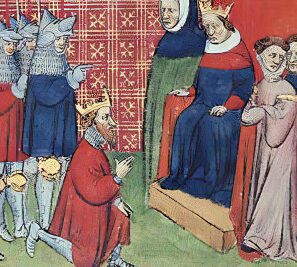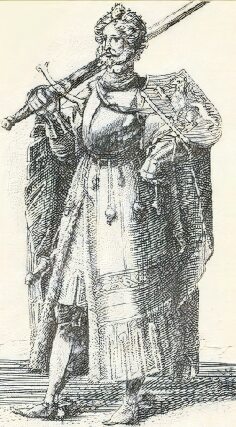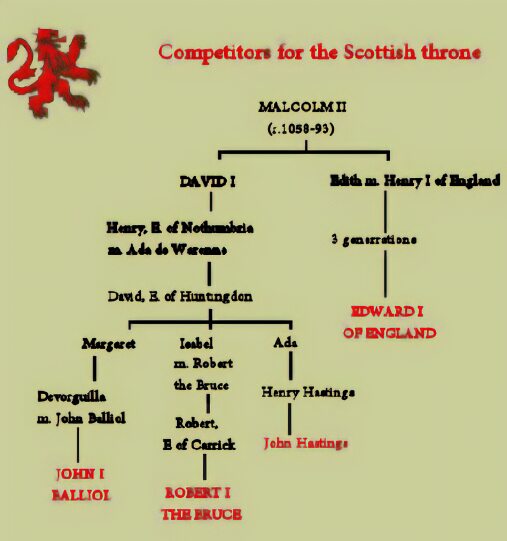King Alexander III
King Alexander III produced three children who all predeceased their father. He, therefore, obtained a promise from the nobles in 1284 to recognise his granddaughter Margaret, "Maid of Norway", the daughter of Erik II of Norway and Alexander's daughter, Margaret of Scotland was the heir to Scotland, who after his death succeeded to the Scottish throne. However, the seven-year-old Margaret died on the Orkney Islands on around 26 September 1290. With her death, the mainline of the House of Dunkeld became extinct and plunging Scotland into crisis as fourteen claimants asserted their rights to the throne.
William Fraser, Bishop of St. Andrews, concerned that civil war would be the result, wrote to King Edward I of England, asking for his assistance in choosing a new king of Scotland. Edward siezed the chance to demand sasine of the Scottish royal estate, but agreed to pass judgment in return for recognition of his suzerainty. The guardians of Scotland would not grant this, but de Brus paid homage to the English king. All the claimants eventually swore oaths of homage, John Balliol being the last to do so. The guardians were forced to concede on the issue.
John Balliol
John Balliol pays homage to Edward I
John Balliol was son of John Balliol by his wife Devorguilla of Galloway, daughter of Alan, Lord of Galloway by his wife Margaret, eldest daughter of David, Earl of Huntingdon, son of Henry, Earl of Huntingdon, son of King David I.
Robert de Brus, 5th Lord of Annandale
Robert de Brus, 5th Lord of Annandale, son of Robert de Brus, 4th Lord of Annandale and Isabella, second daughter of David, Earl of Huntingdon, son of Henry, Earl of Huntingdon, son of King David I and grandfather of King Robert I.
Robert de Brus was the Regent of Scotland during the minority of King Alexander III and was the king's closest surviving male relative. He was occasionally recognized as a Tanist of the Scottish Throne. In the succession dispute, he pleaded tanistry and proximity in a degree of kinship to the deceased King. Robert de Brus later resigned from the lordship of Annandale and his claim to the Scottish throne to his eldest son Robert de Brus.
King Edward I of England.
Edward I based claim to the Scottish throne on his descent from Malcolm III's daughter Edith of Scotland , the wife of Henry I of England, whose daughter Matilda had been the mother of Edward's great-grandfather, Henry II of England. Edward was also the brother-in-law of Alexander III, who had married Edward's sister Margaret of England. Edward was aware that his claim was not strong, and entered it only as a formality and to affirm his position as president of the court.
John the Red Comyn, Lord of Badenoch
John Comyn, known as the Red Comyn was the son of John Comyn, Lord of Badenoch, otherwise known as the Black Comyn, who based his claim on his descent from King Donald III of Scotland, his grandmother, Hextilda, who married Richard Comyn, was the daughter of Uchtred, Lord of Tynedale, and Bethoc, the daughter of Donald III.
John's mother was Eleanor Balliol, the eldest daughter of John I de Balliol and Margaret the parents of King John Balliol. Margaret was the daughter of David, Earl of Huntingdon, the grandson of King David I. The Red Comyn thereby combined two lines of royal descent, Gaelic and Norman. At the outset of the Scottish Wars of Independence, the Comyns were one of Scotland's most dominant families
The emnity between the Coomyns and the Bruces culminated in the murder of the Red Comyn by Robert the Bruce, grandson of the Competitor,on 10 February 1306 at the Church of the Grey Friars in Dumfries.
Floris V, Count of Holland
Floris V, Count of Holland was the son of William II, Count of Holland, himself the son of Floris IV, Count of Holland, son of William I, son of Floris III, Count of Holland by his wife Ada, daughter of Henry, Earl of Huntingdon, son of King David I.
Floris V, Count of Holland Floris claimed that Earl David had given up his right to the throne to his brother William in exchange for a grant of land in Aberdeenshire. If true, this would make Floris the rightful King of Scotland. Floris claimed that although he did not possess copies of the documents detailing the handover of power one must exist somewhere in Scotland and Edward postponed the court for a full ten months while a search was made through various castle treasuries. No copy was found at the time, but copies later surfaced at Pluscarden. One of the early "certified copies", dating the certification seals of the bishop of Moray and the prior of Pluscarden to 1291, is currently located in the Hague. This document is thought to be a forgery.
Floris claimed that Earl David had given up his right to the throne to his brother William in exchange for a grant of land in Aberdeenshire. If true, this would make Floris the rightful King of Scotland. Floris claimed that although he did not possess copies of the documents detailing the handover of power one must exist somewhere in Scotland and Edward postponed the court for a full ten months while a search was made through various castle treasuries. No copy was found at the time, but copies later surfaced at Pluscarden. One of the early "certified copies", dating the certification seals of the bishop of Moray and the prior of Pluscarden to 1291, is currently located in the Hague. This document is thought to be a forgery.
Floris's case was rejected for lack of evidence. However, there is evidence that he entered into an agreement with Bruce in which if one of them was to successfully claim the throne, he would grant the other one-third of the kingdom as a feudal fief. Other clauses in the agreement strongly suggest that of the two, only Bruce could expect to be a successful claimant. This has been interpreted to mean that Floris and Bruce were in collusion, with Bruce hoping that taken together their arguments could defeat Balliol, with Bruces' claim then being upheld in favour of Floris'. It is striking that there is no record of Bruce and Floris being at loggerheads during the proceedings.
John Hastings, 1st Baron Hastings
John Hastings, 1st Baron Hastings, son of Henry de Hastings, son of Ada, third daughter of David, Earl of Huntingdon, son of Henry, Earl of Huntingdon, son of King David I.
Hastings was an Englishman with extensive estates in Scotland, Hastings and had fought from the 1290s in the Scottish, Irish and French wars of King Edward I and was later Seneschal of Aquitaine. He had his lawyers argued that Scotland was not a true kingdom at all, based, amongst other things, on the fact that Scots kings were traditionally neither crowned nor anointed. As such, by the normal rules of feudal law the kingdom should be split amongst the direct descendants of the co-heiresses of David I. Unsurprisingly, a court made up of Scots nobles rejected these arguments.
Patrick Dunbar, 7th Earl of Dunbar
Patrick Dunbar, 7th Earl of Dunbar, was the son of Patrick, 6th Earl of Dunbar, son of Patrick, 5th Earl of Dunbar, son of Patrick, 4th Earl of Dunbar by his wife Ada, natural daughter of King William the Lion. His other claim was as the agnate of the House of Dunkeld, being (a) the closest agnate, and (b) a candidate based on tanistry of agnates of the house where Alexander III belonged to.
He descended, in an allegedly legitimate unbroken male line, from a younger brother of King Duncan I of Scotland (who allegedly also was a younger son of Bethóc, the male line being that of Lords of Dunbar, originally Earls of Northumbria, later Earls of Dunbar. His son became recognized as the Earl of the Scottish Marches. Also, an additional claim in his favour was that made by his wife, Marjory, daughter of Alexander Comyn, Earl of Buchan, allegedly descended from King Donald III.
Along with the Earl of Angus, Robert Bruce the elder, and his son the Earl of Carrick, he swore fealty to Edward I at Wark on 25 March 1296. In the same year, he was betrayed by his wife, Marjorie, daughter of Alexander Comyn, Earl of Buchan, who took the Scottish side and retained the castle of Dunbar for Balliol, but was obliged to surrender it to King Edward I of England in April 1296. In 1297 it appears that the Earl ceased his allegiance to Edward I, held his lands of the Scottish Crown, and was favourably received by Sir William Wallace. In 1298 he was King's Lieutenant for Scotland, and in 1300 was present at the siege of Caerlaverock Castle, with his eldest son and heir, Patrick.
William de Vesci, Baron de Vesci
William de Vesci, Baron de Vesci and lord of Alnwick, was the grandson of King William's mistress Margaret, herself the granddaughter of Adam, laird of Whitsome in Berwickshire son of William de Vesci, was the son of Eustace de Vesci by his wife Margaret, natural daughter of King William the Lion.
William de Ros, 2nd Baron de Ros

William de Ros, 2nd Baron de Ros, son of Robert de Ros, 1st Baron de Ros, son of William de Ros, of Hamlake, son of Robert de Ros by his wife Isabella, the natural daughter of King William the Lion.
He was later appointed Lord High Admiral and was one of the commissioners with the Archbishop of York, and others, to negotiate peace between King Edward II of England and Robert de Bruce, who had assumed the title of king of Scotland.
Robert de Pinkeney
Robert de Pinkeney, a Northamptonshire baron was the son of Henry de Pinkeney by his wife Alicia, daughter of John Lindesay by his wife Marjorie, an alleged natural daughter of Henry, Earl of Huntingdon, son of King David I.
Nicholas de Soules
Nicholas de Soules, a member of the family of the lords of Liddesdale, was the son of William II de Soules by his wife Ermengarde, daughter of Alan Durward by his wife Marjorie, natural daughter of King Alexander II
Patrick Galithly
Patrick Galithly, a burgess of Perth and the son of Henry Galithly, who Patrick claimed was the natural son of King William the Lion.
Roger de Mandeville
Roger de Mandeville came of an Anglo-Norman family who had settled in Ulster, the son of ... de Mandeville by his wife Agatha, daughter of Robert Wardone by his wife Aufrica, daughter of William de Say who was the son of Aufrica, natural daughter of King William the Lion.
Eric II, King of Norway
Eric II, King of Norway, the eldest surviving son of King Magnus the Lawmender of Norway, and his wife Ingeborg Eriksdatter, daughter of King Eric IV of Denmark, had married Princess Margaret of Scotland and was the father of Queen Margaret and son-in-law of King Alexander III. Eric later married Isabel Bruce, sister of King Robert I of Scotland.
King Edward I gave judgment on the Scottish case on November 17, 1292, in favour of John Balliol
Robert de Brus PreviousNext Marjorie Bruce
